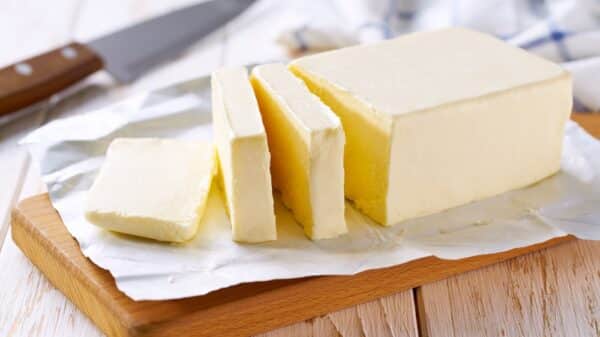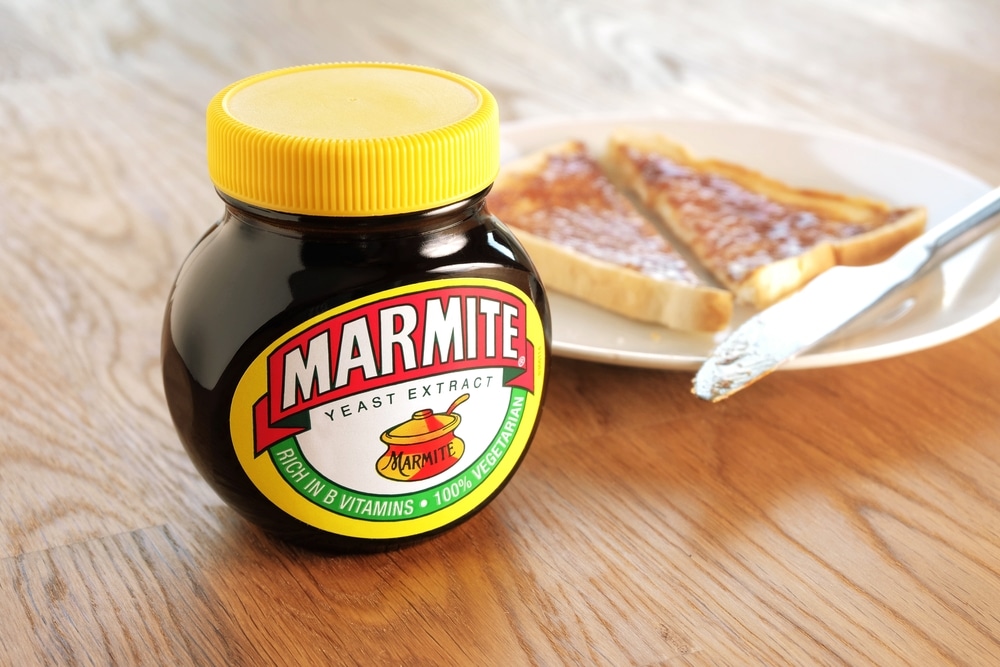A brief search on Google will inform you that it’s a yeast extract, but that barely scratches the surface. Fortunately, you have me, a British Marmite enthusiast, to clarify the details of this rather peculiar viscous spread. I’m fully aware that it’s odd but delicious — for some — and significantly more adaptable than many people realize.
I’m about to provide you with insights into the background of Marmite, what it genuinely is, its flavor profile, and ways to incorporate it into your meals. Before long, you’ll be uttering “pip pip” and ” alright mate” on your way to the British food section in your nearby supermarket, eager to clear the shelves of yeast extract.
What is Marmite?
What exactly is Marmite? Well, it’s polarizing. This dark, adhesive spread has ignited discussions in Britain since it was conceived in 1902. I say “conceived,” but Marmite was actually discovered by chance. A German chemist, Justus Liebig, stumbled upon this highly concentrated yeast extract, a by-product of beer production, which turned out to be consumable. He established the Marmite Food Company in Burton-on-Trent, and from that moment on, the world of spreads would never be the same. Because why should something potentially nutritious be wasted when you can smother it on your toast instead?
Marmite typically comes in jars that sit proudly next to other beloved spreads such as jam and peanut butter, giving you an idea of its intended use. But don’t underestimate this sticky delight; it’s far more versatile than meets the eye. Its oddly gooey texture does, however, mean you may find the outside of the jar frustratingly sticky. But have no fear! This unassuming jar is not just a standalone treat — you can also find Marmite-flavored crisps, nuts, and a plethora of snacks lining the shelves of U.K. grocery stores.
The name “Marmite” itself is derived from the French word for a type of cooking pot. In earlier versions, you could even spot an image of such a pot on the label! By the 1920s, Marmite had secured its spot as a British household staple, advertised as a health food thanks to its impressive vitamin B content. It even found its way into the hands of soldiers during World War I, demonstrating just how seriously the Brits regard their savory spreads.
What does Marmite taste like?
Describing Marmite’s flavor is a bit like trying to explain the dreams of a David Lynch character — no matter how you spin it, it’s going to sound peculiar to those who haven’t experienced it. Marmite is intensely savory, salty, and packed with umami. If you can picture soy sauce, miso, and a touch of burnt caramel all hugging it out in one dish, you’re getting warmer. The product itself embraces the motto “you either love it or you hate it,” and frankly, that says a lot about this little jar of joy.
For those in the “love it” camp, every bite is a burst of flavor that’s impossible to replicate. Conversely, if you’re not on board, it might just seem like an acquired taste that hasn’t been quite cultivated. Marmite stands out; it’s bold, assertive, and unapologetic about its unique flavor. To truly understand it, you’ve got to give it a try — and then perhaps try again just to make sure you really comprehend its essence.
I have to admit, I’m a proud member of the “love it” crew, but I completely get that it’s not everybody’s cup of tea. The trick, however, is all about moderation. Over-spread it, and it may overwhelm your perfectly good toast. Add too much into a dish, and it will take center stage in a rather overpowering manner. But sprinkle a little here and there, and you’ll find it enhances everything from cheese sandwiches to gravy. If you’re trying it for the first time, take it slow. Remember, Marmite isn’t here to make friends; it’s here to make a statement.
Are Marmite and Vegemite the same?
So now you’ve got your head wrapped around what Marmite is… but what about Vegemite? Is the only thing separating them British origins from Australian? Well, there’s a bit more to unpack than that, so let’s break down the distinctions between these two spreads.
To start, their textures are noticeably different. Marmite is sticky, reminiscent of honey, while Vegemite is thicker and more paste-like, a bit like peanut butter. When it comes to flavor, Marmite offers a hint of sweetness alongside its savory kick, but it also introduces a tang that might be a bit off-putting for some. Meanwhile, Vegemite goes deeper and saltier with a more pronounced yeast flavor and lacks the same tang, resulting in a flavor profile that others might consider milder.
That said, it’s largely a matter of personal preference. Most Brits would likely grab a jar of Marmite without a second thought, while most Australians might wrinkle their noses at the idea of having Marmite in their pantry.
Marmite is traditionally consumed on toast
If you’re still scratching your head over how to actually use Marmite, let’s start simple — it’s most commonly enjoyed as a spread on toast and in sandwiches. While these might not be the only ways to enjoy it, they’re perfect for beginners and definitely a good place to start.
The classic way to relish it is by spreading a thin layer over buttered toast. Both the moderation of the Marmite and the lushness of the butter are key; they save many newbies from consequently drowning themselves in flavor. Making a Marmite sandwich is also a nostalgic lunchbox staple from childhood.
But why limit yourself to just toast and sandwiches? My favorite pairing is with fresh tomatoes. The juicy sweetness of the tomatoes beautifully counters the saltiness and savoriness of Marmite. A sprinkle of fresh black pepper can elevate the experience even further. Cheese makes another fantastic companion — sharp cheddar is a tried-and-true choice, but even mild Swiss cheese pops with a touch of Marmite. Try it in a warm cheese toastie, and you’re in for a treat.
Feeling adventurous? Spread it alongside peanut butter. Yes, it might sound a bit unusual, but this salty-savory-sweet combo is surprisingly delightful. So much so that you can even purchase Marmite-infused peanut butter here in the U.K.
It’s also great with noodles
Marmite can be so much more than just a topping for toast! Allow me to introduce you to its hidden talent as a noodle sauce. Adding Marmite is an amazing way to include those irresistible umami notes into hot, buttery spaghetti or any noodle dish that’s craving a little extra flavor.
This delicious idea gained popularity through Nigella Lawson’s spaghetti recipe featuring Marmite as an unexpected star. And really, who would be surprised? It’s Marmite! This dish couldn’t be simpler. Just melt a decent knob of butter into your spaghetti, stir in a spoonful of Marmite, and voilà! You’ve elevated your everyday pasta into something delightfully rich and flavorful, each bite more satisfying than the last.
cooking or an extensive list of exotic ingredients. Imagine the satisfaction of serving a spaghetti dish that tastes like it has been simmering for hours, all thanks to just a hint of Marmite.
The process is incredibly straightforward. As you prepare your sauce, simply add a teaspoon of Marmite along with your usual spices and herbs. It will meld beautifully with your onions, garlic, and tomatoes, providing a depth that transforms an ordinary weeknight meal into something remarkable. The key is to incorporate it slowly — start with a little and build to your desired flavor. Before you know it, your family will be spooning up servings of that rich, savory sauce, wondering how you made it taste so good.
What’s more, Marmite isn’t just about enhancing flavor; it’s brimming with B vitamins, providing a nutritional boost that’s often overlooked. It’s a fun way to sneak in some extra goodness to meals without sacrificing taste or enjoyment.
When it comes to serving, don’t forget to sprinkle some fresh herbs or grated cheese on top to make the dish pop — after all, we eat with our eyes first. Depending on your preference, whether you love a classic spaghetti with a meaty sauce or a simple marinara, adding Marmite will elevate your cooking game with minimal effort. It’s not just about preparing a meal; it’s about sharing the experience of good food with loved ones, reminding us that sometimes, the simplest twists make all the difference in a dish.
Armed with a jar of Marmite and a little creativity, you might find yourself exploring even more culinary avenues. It’s a trusted ally in the kitchen, transforming dishes that might otherwise be lackluster into something memorable. Whether you’re a Marmite enthusiast or a curious newcomer, embracing this unique ingredient could be just what you need to spice things up — in more ways than one.When it comes to cooking flavorful vegetarian dishes, there’s a secret weapon that you might want to keep on hand: Marmite. This rich yeast extract is surprisingly versatile and can infuse deep, savory notes into your pasta sauces, providing that umami punch usually reserved for hearty ingredients like sausage or pancetta. Picture your next spaghetti night—just a spoonful of Marmite added to your sauce can elevate it from plain to extraordinary, ensuring it’s a hit with everyone at the table. So, before you head out for groceries, make sure you add Marmite to your shopping list. It truly is a lifesaver.
Moving away from traditional sweet treats, savory muffins are carving their place in our breakfast routines, and guess who would love to join the party? That’s right—Marmite. Forget about those overly sweet blueberry muffins; there’s a whole world of savory goodness waiting to be explored. Savory muffins are not just trendy but are also a more beneficial breakfast choice, as they lessen the likelihood of that dreaded mid-morning sugar crash.
Incorporating Marmite into your muffin batter is as easy as pie—just stir in a teaspoon or so, and you’ll be amazed by the flavor that permeates each bite. Feeling adventurous? There are ample recipes available online to guide you, or you can easily enhance your favorite muffin recipe. Just think of the delightful combinations; cheddar cheese, zesty herbs, and sweet caramelized onions all mingle beautifully with Marmite in your muffins.
And if you want to think outside the breakfast box, these muffins are perfect alongside a warm bowl of soup or can even replace dinner rolls. But my personal favorite? Slicing a warm muffin in half and slathering it with butter while it’s still blissfully hot. It’s a simple pleasure that truly elevates your day. So while Marmite muffins might not be your classic go-to, their unique charm is precisely what makes them so appealing. Plus, Marmite’s adaptability means you can sneak it into just about any savory bake you can dream up.
And let’s talk breakfast essentials—eggs and Marmite typically don’t share the spotlight, which is a missed opportunity! If you often find your scrambled eggs lacking that certain something, adding a touch of Marmite could be your game changer. Just whisk in a small bit or melt it into the butter before you add your beaten eggs; you’ll experience a whole new level of savory richness that beautifully highlights the natural flavors of the eggs without stealing the show.
For those of you who lean more towards baked eggs, try spreading a little Marmite around the inside of your ramekin before cracking your egg in, followed by a splash of cream or a sprinkle of cheese. As it cooks, the Marmite transforms, melding with all the ingredients to create a dish bursting with savory delight. It’s the perfect comfort food for a relaxed weekend breakfast or brunch, requiring minimal effort while looking immensely impressive.
Don’t forget about the omelette—Marmite fits right in here too. Simply mix a bit of it into your eggs before cooking and fill your omelette with your favorite ingredients—mushrooms, cheese, or whatever else you have on hand. Trust me, once you’ve indulged in Marmite eggs, going back to plain eggs will feel a little bit less exciting. You might just discover a new breakfast staple that makes your mornings a lot more delightful.
So next time you’re in the kitchen, don’t overlook the transformations that Marmite can bring to your meals. Whether it’s adding depth to your pasta sauce, creating the latest savory muffin craze, or enhancing your go-to egg dish, Marmite has got your back. Give it a try and enjoy the deliciousness that ensures your meals are anything but ordinary.































